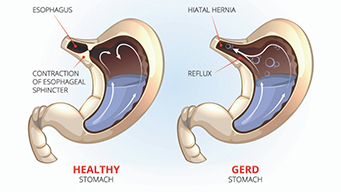Many of us know enjoying larger portions during the holiday season or trying different foods outside our normal diet plan, can initiate uncomfortable indigestion and heartburn. However, long after the decorations, cookie cutters and crock pots have been stored away, what if there is or has always been a lingering stomach issue?
Some of us tend to brush off stomach issues, but when symptoms of belching, heartburn, regurgitation, dysphagia or increased salivation persist leading to discomfort and suffering, you may be one of the 30-40% of Americans dealing with GERD. This would be an appropriate time for you to consult with your physician. While acid is necessary and a completely normal feature of your stomach that helps digest food – there can be real consequences when the esophagus becomes irritated as stomach contents, including acid, flows upwards from the stomach. Frequently, the cause of the symptoms may result from a weak lower esophageal sphincter.
It is important for you to understand what might be triggering your symptoms. A diet screening, including a three-day (one weekend day) food diary which tracks time, food, portion, activity and symptoms, will assist your physician in determining a pattern of eating. Your level of self-care independence is important, in addition to:
- Food allergies, preferences, and intolerances, specifically pepper, spicy foods, spearmint, peppermint, chocolate, high-fat foods, caffeinated beverages including coffee, tea, and carbonated drinks
- History of food restrictions
- Ethnic cultural, and religious influences
- Alcohol use
- Use of vitamins, minerals, or herbal supplements
Nutrition Interventions
The following foods may be eliminated or limited to lessen symptoms of GERD:
- Peppermint and spearmint
- Chocolate
- Alcohol
- Caffeinated beverages (regular tea, coffee, colas, energy drinks, other caffeinated soft drinks)
- Pepper
- Fruits and vegetables that may cause symptoms (these items will be individualized)
A low-fat diet is recommended. Foods that should be eliminated or limited include:
- Reduced-fat (2%) milk, whole milk, cream, high-fat cheeses, high-fat yogurt, chocolate milk, cocoa
- Fried meats, bacon, sausage, pepperoni, salami, bologna, frankfurters/hot dogs
- Other fried foods (doughnuts, french toast, french fries, deep-fried vegetables)
- Nuts and nut butters
- Pastries and other high-fat desserts
- More than 8 teaspoons of oil, butter, shortening per day
Lifestyle and behavioral changes may help reduce the frequency of symptoms:
- Eat small, frequent meals
- Eat food at a calm and relaxed pace; chewing thoroughly
- Maintain a healthy weight
- Avoid tight-fitting clothes that put pressure on your abdomen
- Smoking cessation
- Elevate the head of your bed 6 to 9 inches
Nutrition Goals – Overcoming GERD
The good news is that with a little patience and proper balance, GERD can be managed and then prevented. These nutrition interventions should be implemented to achieve the following outcomes:
- Slow, gradual weight loss, if needed
- Decrease gastric acidity
- Improve lower esophageal sphincter competence
- Identify drug-nutrient interaction
- Prevent esophageal obstruction
(www.nutritioncaremanual.org)
References
-
www.mayoclinic.org/disease-conditions/GERD
-
Philip Katz, MD, Lauren Gerson, MD, MMSc Marcelo Vela, MD MSCR, Guidelines for the Diagnosis and Management of Gastroesophageal Reflux Disease, Am J Gastroenterology, February, 2013
-
https://www.niddk.nih.gov/health-information/digestive-diseases/acid-reflux-ger-gerd-adults
-
https://www.nutritioncaremanual.org

